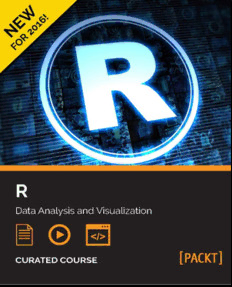Table Of ContentW
!
E 6
1
N 0
2
R
O
F
R
Data Analysis and Visualization
</>
CURATED COURSE
R
Data Analysis and Visualization
A course in five modules
Master the art of building analytical models using R with your
Course Guide Edwin Moses
Learn data analysis, data visualization techniques, data mining, and machine
learning all using R and also learn to build models in quantitative finance using
this powerful language
To contact your Course Guide
Email: edwinm@packtpub.com
BIRMINGHAM - MUMBAI
Meet Your Course Guide
Welcome to this course on R, the statistical programming language for data scientists
and statisticians. With this course, you'll embark on a journey of learning R for data
science.
This course has been designed for you by me Edwin
Moses—your Course Guide. I am here to help you
experience a wonderful journey on a tried and tested path.
I've designed this course for you and you'll be seeing me
through the whole journey, offering you my thoughts and
ideas behind what you're going to learn next and why
I recommend each step. I'll provide tests and quizzes to
help you reflect on your learning, and code challenges
that will be pitched just right for you through the course.
If you have any questions along the way, you can reach out to me over email and
I'll make sure you get everything from the course that we've planned – for you to
become a working R developer. Details of how to contact me are included on the
first page of this course.
Course Structure
The R learning path created for you has five connected modules. Each of these
modules are a mini-course in their own right, and as you complete each one,
you'll have gained key skills and be ready for the material in the next module!
Now, let’s look at the pathway these modules create and how they will take you from
doing data analysis with R to creating analytical models based on machine learning.
Course journey
This course begins by looking at the Data Analysis with R module. This module will
help you navigate the R environment. You'll gain a thorough understanding of
statistical reasoning and sampling. Finally, you'll be able to put best practices into
effect to make your job easier and facilitate reproducibility.
The second place to explore is R Graphs. This module will help you leverage
powerful default R graphics and utilize advanced graphics systems such as lattice
and ggplot2, the grammar of graphics. Through inspecting large datasets using
tableplot and stunning three-dimensional visualizations, you will know how to
produce, customize, and publish advanced visualizations using this popular,
and powerful, framework.
With the third module, Learning Data Mining with R, you will learn how to manipulate
data with R using code snippets and be introduced to mining frequent patterns,
association, and correlations while working with R programs. Discover how to write
code for various predication models, stream data, and time-series data. You will also
be introduced to solutions written in R based on RHadoop projects. You will finish
this module feeling confident in your ability to know which data mining algorithm
to apply in any situation.
The Mastering R for Quantitative Finance module pragmatically introduces both
the quantitative finance concepts and their modeling in R, enabling you to build
a tailor-made trading system on your own. By the end of the module, you will be
well versed with various financial techniques using R and will be able to place
good bets while making financial decisions.
Finally, we'll look at the Machine Learning with R module. With this module,
you'll discover all the analytical tools you need to gain insights from complex data
and learn how to choose the correct algorithm for your specific needs. Through full
engagement with the sort of real-world problems data-wranglers face, you'll learn to
apply machine learning methods to deal with common tasks, including classification,
prediction, forecasting, market analysis, and clustering.
The Course Roadmap and Timeline
Here's a view of the entire course plan before we begin. This grid gives you a topic
overview of the whole course and its modules, so you can see how we will move
through particular phases of learning to use R, what skills you’ll be learning along the
way, and what you can do with those skills at each point. I also offer you an estimate
of the time you might want to take for each module, although a lot depends on your
learning style how much you’re able to give the course each week!
Module 1: Data Analysis with R
Chapter 1: RefresheR 3
Navigating the basics 3
Getting help in R 9
Vectors 10
Functions 16
Matrices 19
Loading data into R 22
Working with packages 25
Chapter 2: The Shape of Data 29
Univariate data 29
Frequency distributions 30
Central tendency 34
Spread 38
Populations, samples, and estimation 41
Probability distributions 43
Visualization methods 48
Chapter 3: Describing Relationships 57
Multivariate data 57
Relationships between a categorical and a continuous variable 58
Relationships between two categorical variables 63
The relationship between two continuous variables 66
Visualization methods 74
Chapter 4: Probability 83
Basic probability 83
A tale of two interpretations 89
Sampling from distributions 90
The normal distribution 94
[ i ]

